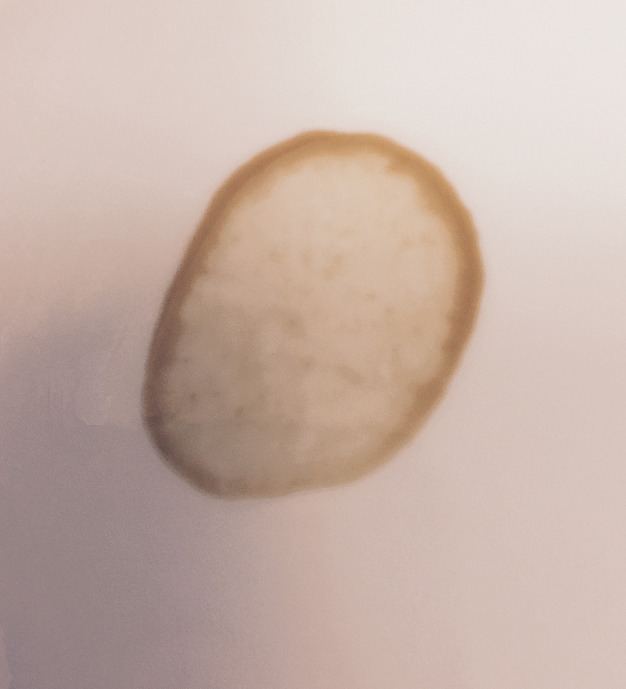 | ||
In physics, a "coffee ring" is a pattern left by a puddle of particle-laden liquid after it evaporates. The phenomenon is named for the characteristic ring-like deposit along the perimeter of a spill of coffee. It is also commonly seen after spilling red wine. The mechanism behind the formation of these and similar rings is known as the coffee ring effect or in some instances, the coffee stain effect, or simply ring stain.
Contents
Flow mechanism
Writing in Nature, Robert D. Deegan of The University of Chicago and coworkers show that the pattern is due to capillary flow induced by the differential evaporation rates across the drop: liquid evaporating from the edge is replenished by liquid from the interior. The resulting edgeward flow can carry nearly all the dispersed material to the edge.
Follow-up work by Hu and Larson suggests the evaporation induces a Marangoni flow inside a droplet. The flow, if strong, actually redistributes particles back to the center of the droplet. Thus, for particles to accumulate at the edges, the liquid must have a weak Marangoni flow, or something must occur to disrupt the flow. For example, surfactants can be added to reduce the liquid's surface tension gradient, disrupting the induced flow. Hu and Larson do mention that water has a weak Marangoni flow to begin with, which is then reduced significantly by natural surfactants.
H. Burak Eral and colleagues in the Physics of Complex Fluids group at the University of Twente evoked alternating voltage electrowetting to suppress coffee stains noninvasively (i.e. no need to add surface active materials).
Recently, Byung Mook Weon of Sungkyunkwan University and Jung Ho Je of Pohang University of Science and Technology showed an observation of reverse particle motion that repels the coffee-ring effect because of the capillary force near the contact line. The reversal takes place when the capillary force prevails over the outward coffee-ring flow by the geometric constraints.
Surface Tension Effects
The coffee-ring effect was thought to have formed as a result of fluid flow inside the drop or stain. However, in December 2016 researchers at the University of Nevada, Reno, found that interaction of the particles suspended in a droplet with the free surface of the droplet was important in creating the ring.
Hassan Masoud said, "When the drop evaporates, the free surface collapses and traps the suspended particles. Our theory shows that eventually all the particles are captured by the free surface and stay there for the rest of their trip towards the edge of the drop."
This discovery means that surfactants can be used to manipulate the motion of the solute particles by changing the surface tension of the drop, rather than trying to control the bulk flow inside the drop.
Determinants of size and pattern
Recent work of Bhardwaj et al. showed the pH of the solution of the drop also influences the final deposit pattern. The transition between these patterns is explained by considering how DLVO interactions such as the electrostatic and Van der Waals forces modify the particle deposition process.
At the microscopic level, Shen, Ho, and Wong of University of California, Los Angeles suggest that the lower limiting size of a coffee ring is dependent on the time scale competition between the liquid evaporation and the movement of suspended particles. When the liquid evaporates much faster than the particle movement near a three-phase contact line, coffee ring cannot be formed successfully. Instead, these particles will disperse uniformly on a surface upon complete liquid evaporation. For suspended particles of size 100 nm, the minimum diameter of the coffee ring structure is found to be 10 μm, or about 10 times smaller than the width of human hair. In a study published in Nature in August 2011, a team of University of Pennsylvania physicists has shown that the shape of particles in the liquid is responsible for coffee ring effect. On porous substrates, the competition among infiltration, particle motion and evaporation of the solvent governs the final deposition morphology.
The self-pinning of the contact line by particle confinement was studied by Byung Mook Weon of Sungkyunkwan University and Jung Ho Je of Pohang University of Science and Technology. They suggested that a critical linear packing fraction is required for the self-pinning by a balance between the spreading and the net capillary forces at the contact line.
Applications
The coffee ring effect is utilized in convective deposition by researchers wanting to order particles on a substrate using capillary-driven assembly. Utilized by various groups including Velev at North Carolina State University and Gilchrist at Lehigh University using principles developed by Dimitrov and Nagayama, replacing a stationary droplet with an advancing meniscus drawn across the substrate. This process differs from dip-coating in that evaporation drives flow along the substrate as opposed to gravity.
Dongmao Zhang et al. have utilized the coffee-ring drying pattern to pre-concentrate the protein solutions prior to Raman analysis in so called Drop Coating Deposition Raman (DCDR) technique.
Hosein and co-workers showed that convective deposition also had the ability to control particle orientation, resulting in the formation of crystalline monolayer films from nonspherical particles such as hemispherical, dimer, and dumbbell shaped particles. Orientation is afforded by the system trying to reach a state of maximum packing of the particles in the thin meniscus layer over which evaporation occurs. They showed that tuning the volume fraction of particles in solution will control the specific location along the varying meniscus thickness at which assembly occurs. Particles will align with their long axis in- or out-of-plane depending on whether or not their longer dimension of the particle was equal to the thickness of the wetting layer at the meniscus location. Such thickness transitions were established with spherical particles as well. It was later shown that convective assembly could control particle orientation in assembling multi-layers, resulting in long-range 3D colloidal crystals from dumbbell shaped particles. These finds were attractive for the self-assembled of colloidal crystal films for applications such as photonics.
